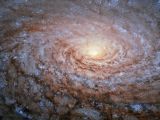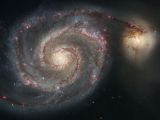The Hubble Space Telescope, designed and built by NASA and ESA researchers, was launched in orbit in 1990. It has since been hovering over our heads at an altitude of roughly 350 miles (about 560 kilometers), circling Earth at a speed of 17,000 miles per hour (27,000 kilometers per hour).
Since its launch many years ago, the Hubble Space Telescope has helped further our understanding of the near and distant cosmos, delivering enough data for scientists to ink nearly 13,000 papers.
Recently, Hubble turned its instruments on a distant galaxy dubbed Messier 63 and produced a stunning view revealing its intricate makeup. The image, made public by NASA this Friday, is available in the gallery below.
This faraway galaxy imaged by Hubble was discovered in 1779 by French astronomer Pierre François André Méchain. Then, in 1781, it was described in a catalogue put together by another French astronomer, Charles Messier.
The galaxy resembles a sunflower
Like our Milky Way, Messier 63 is a spiral galaxy. It lies in the constellation Canes Venatici (the Hunting Dogs), at a distance of about 27 million light-years from our Solar System.
Astronomers describe the galaxy as having a central disc from which many short spiral arms emerge. In the image delivered by the Hubble Space Telescope, as well as in other previous views, it resembles a sunflower.
“The arrangement of the spiral arms in the galaxy Messier 63, seen here in an image from the NASA / ESA Hubble Space Telescope, recall the pattern at the center of a sunflower.”
“So the nickname for this cosmic object - the Sunflower Galaxy - is no coincidence,” NASA astronomers write in the description accompanying Hubble's portrait of Messier 63.
The reason the galaxy's arms shine especially bright in this image is because they are home to many young stars born from clouds of gas and dust. Of these stars, some are blue-white giant stars.
Together with other galaxies, Messier 63 is part of a larger cosmic pack called the M51 Group after its absolute brightest member, i.e. Messier 51, another spiral giant that's also known as the Whirlpool Galaxy.

 14 DAY TRIAL //
14 DAY TRIAL // 

